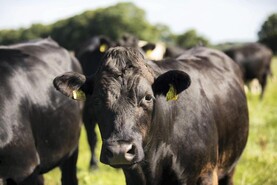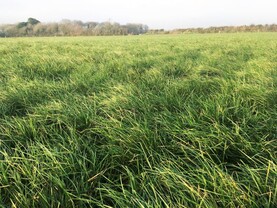If phase one and two of the BETTER Farm programme taught us anything, it was that suckler to beef operations were, on average, the most profitable beef farming systems. Looking at the figures, the final e-Profit Monitors completed for phase two participants demonstrated that the average gross margin/ha on finishing farms was €1,241/ha, well above that of sole trading systems and suckler to weanling/store operations at €785/ha and €792/ha, respectively.
Upon commencement of the current phase of the BETTER farm programme, there were only six bull beef producers. Now, less than two years later, there are 16 farmers operating this system – evidence, perhaps, that many of the programme farmers are looking to capitalise on this potential gross margin increase. But why bull beef as opposed to steer beef? Research has shown that a bull will grow around 16% faster than a steer under similar conditions. Their increased tendency to grow lean muscle leads to a higher rate of beef output per unit of feed going in – be it grass or concentrates. The second way that a bull boosts a farm’s output is by freeing up farm resources. While steer systems typically require two full seasons at grass and two winters, bulls require either one or one-and-a-half grazing seasons and almost never need a second winter. Finally, bulls will reach slaughter targets in a fraction of the time that a steer takes. Often times, steers are being kept up to 12 months longer on farms only to achieve the same carcase weight as young bulls. By slaughtering them as bulls, this allows for more room to push cow numbers, or other drystock numbers, and achieve more output per hectare.

Of course, bull beef instead of steer beef comes with its downsides too. First and foremost, the thought of finishing bulls to many farmers sounds like torturous work. Bulls can be notoriously difficult animals to handle on some farms in comparison with steers. For that, accommodation and facilities need to be adequate and in some cases investments in better facilities may not be justifiable. Another reason not to choose the bull beef option is to maximise grass utilisation.
Bull beef is a high-concentrate system. On farms where increasing suckler cows is limited but land and grass is still available to graze, a steer system is probably the best option to utilise this and benefit from cheap weight gain. Finally, and something that is becoming more frequent is labour availability.
With many suckler farms now part-time, finishing bulls intensively might not be realistic and the management of a steer or weanling system might be more suitable for some.
The group of BETTER farm Beef Challenge bull producers detailed here comprises those slaughtering bulls under 16 months of age and those producing older bulls. Both systems have their benefits and disadvantages. The under-16-month bull system is attractive because animals are in spec and are slaughtered on the QPS grid. The pricing structure means animals can avail of a €0.12/kg quality assurance bonus and grading bonuses of €0.06/kg to €0.24/kg depending on carcase specifications. Obviously, the downside to this system is that it can prove very difficult to get bulls fit for slaughter less than 16 months of age and slaughtering under-fit cattle is not beneficial to anyone. The advantages of slaughtering older bulls is that these animals usually get a second season at grass – or at least part of a second season. This is very appealing to farmers looking to avail of cheap weight gain off grass, particularly on bulls that might not come fit for slaughter at 16 months. The downside to this system is that these bulls are technically out of spec and many feel they will be one of the first categories of stock to be ignored by meat processors if pressure comes on. They are not sold on the QPS grid meaning they only receive a flat base price per kg – less than steer base price.
Looking at the group as a whole, performance is good. All data has been taken from ICBF slaughter reports generated for young bull slaughtering over the past 12 months. Average age at slaughter is 17 months and average carcase weight is 388kg.
Going by this, it would be fair to say that most bulls being slaughtered are over 16 months old. After delving deeper into the reports, what becomes apparent very quickly is that most farmers are in fact slaughtering bulls both under 16 months and over 16 months. This is quite common on many farms across the country where, after weaning, the heaviest calves are picked out for intensive feeding to kill under 16 months. The remaining lighter calves are often stored over the winter, turned out to grass early in the spring, given three to four months at grass before being housed for a 90-120 day finishing period.
As mentioned, only six farmers were slaughtering bulls prior to joining the programme – Wesley Browne, Joe Healy, Martin O’Hare, John McSweeney, Maurice Hearne and Tommy Holmes. Since then, there has been five conversions from weanling systems – the Flahertys, the Grieves, Garreth McCormack, Padraig O’Connor and Philip Keville; two conversions from steer beef – the Lalors and Martin Downes; and two conversions from store systems – Nigel O’Kane and Sean Hayes. One farmer, Ger McSweeney, also joined the programme.
The ICBF slaughter report also includes financials on every farm’s slaughter performance. While no one farmer’s price received is singled out here, the average price received at slaughter for beef bulls was €4.15/kg. Looking across the board, farms selling the majority under 16 months received between €4.10/kg and €4.37/kg. Where bulls were sold mainly over 16 months, the price range was less, at €3.90/kg to €4.10/kg.
Another interesting figure included in the report is the lifetime margin of each animal per day. This figure, given in €/day, calculates the average selling price divided by the age of the animal at slaughter.
Across the group, the average was €3.25/day but once again, those selling the majority under 16 months had a higher margin per day (€3.50 - €4.00) than those over 16 months (€2.30 - €3.30).






 This is a subscriber-only article
This is a subscriber-only article









SHARING OPTIONS: